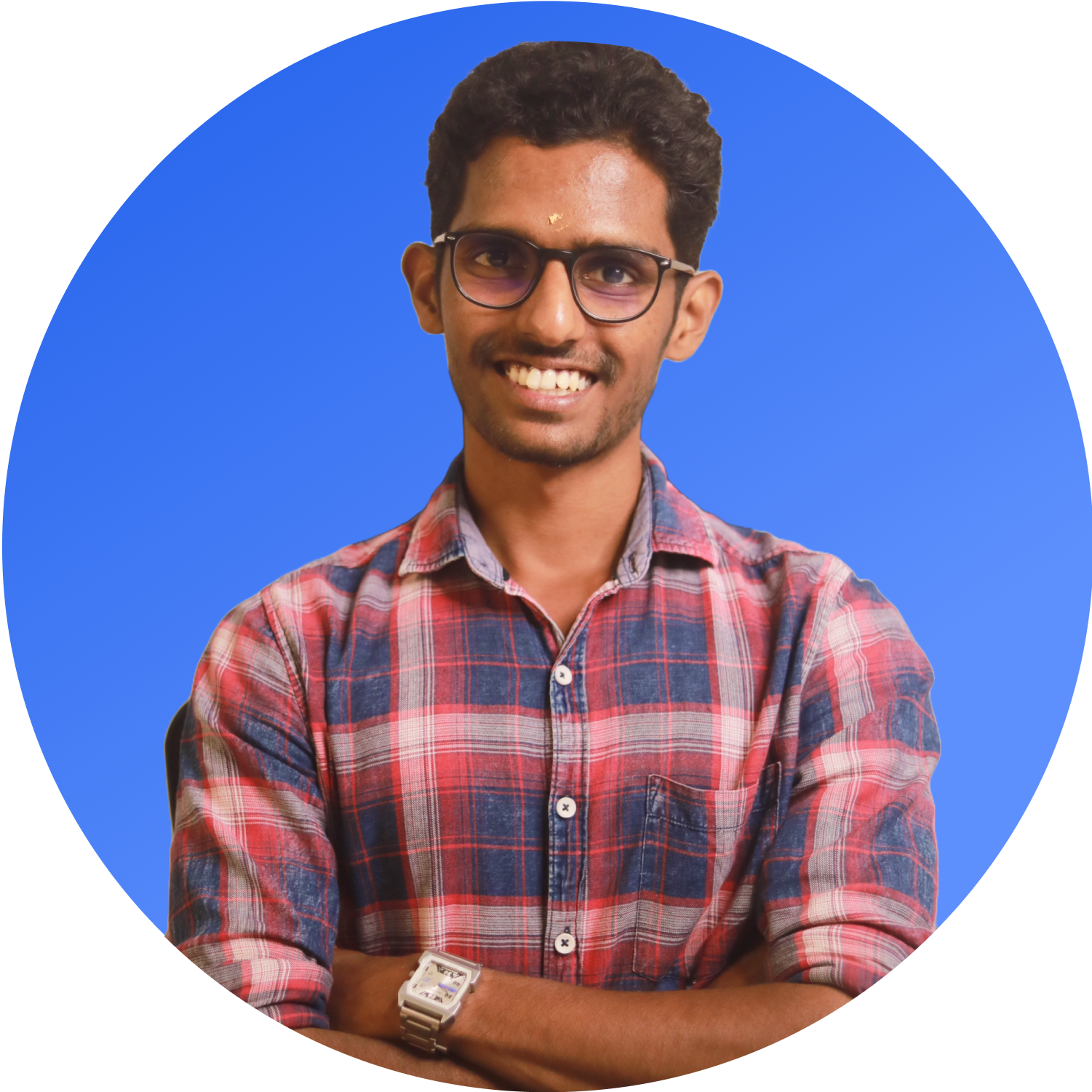Why bother writing a follow-up email?
Can’t we stop sending emails after the initial one?
It’s a work, isn’t it?
That’s what most marketers and salespeople think and feel initially - When they have to write one,
But,
After reading the stats below, your idea about follow-up emails won’t be the same.
(Clears throat)…Now, What do you think?
In this blog post, you’ll learn how to write a follow-up email.
Table of Contents
What is a Follow-Up email?
Why should you send a follow up emails?
Follow-up emails are crucial because 60% of customers say no four times before saying yes. They can boost reply rates by 220% and have higher open rates (30-50%) than initial emails.
Sending 2-3 follow-ups maintains interest without overwhelming, and most sales (80%) occur between the fifth and twelfth contact.
Plus, you have a 25% chance of hearing back if you send more than one email.
When people see your cold email, even if it’s not written with the color of sales-y ness, your prospects won’t be like, “Okay, Alright then, Let’s do this.”
They think, react, and try to move away from your email or message - Mostly because of Reactance psychology - The rule of thumb for cold email is that your prospect says 4 ‘NO’s before they say yes.
It’s like this,
1st time - No
2nd time - …Noo
3rd time - What’s he saying…No!
4th time - Oh, Okay…Still no.
5th time - Let’s try this.
*I don’t know what people might say looking at cold emails in real life
The more follow-up you send, the less threat-free you appear to your prospect —thank you, mere exposure effect— and the more willing they are to consider your offer,
Which increases your chance of converting them into calls or customers.
Here are 7 stats that prove Follow-up emails are worth your time and necessary for your revenue.
How to write a follow-up email?
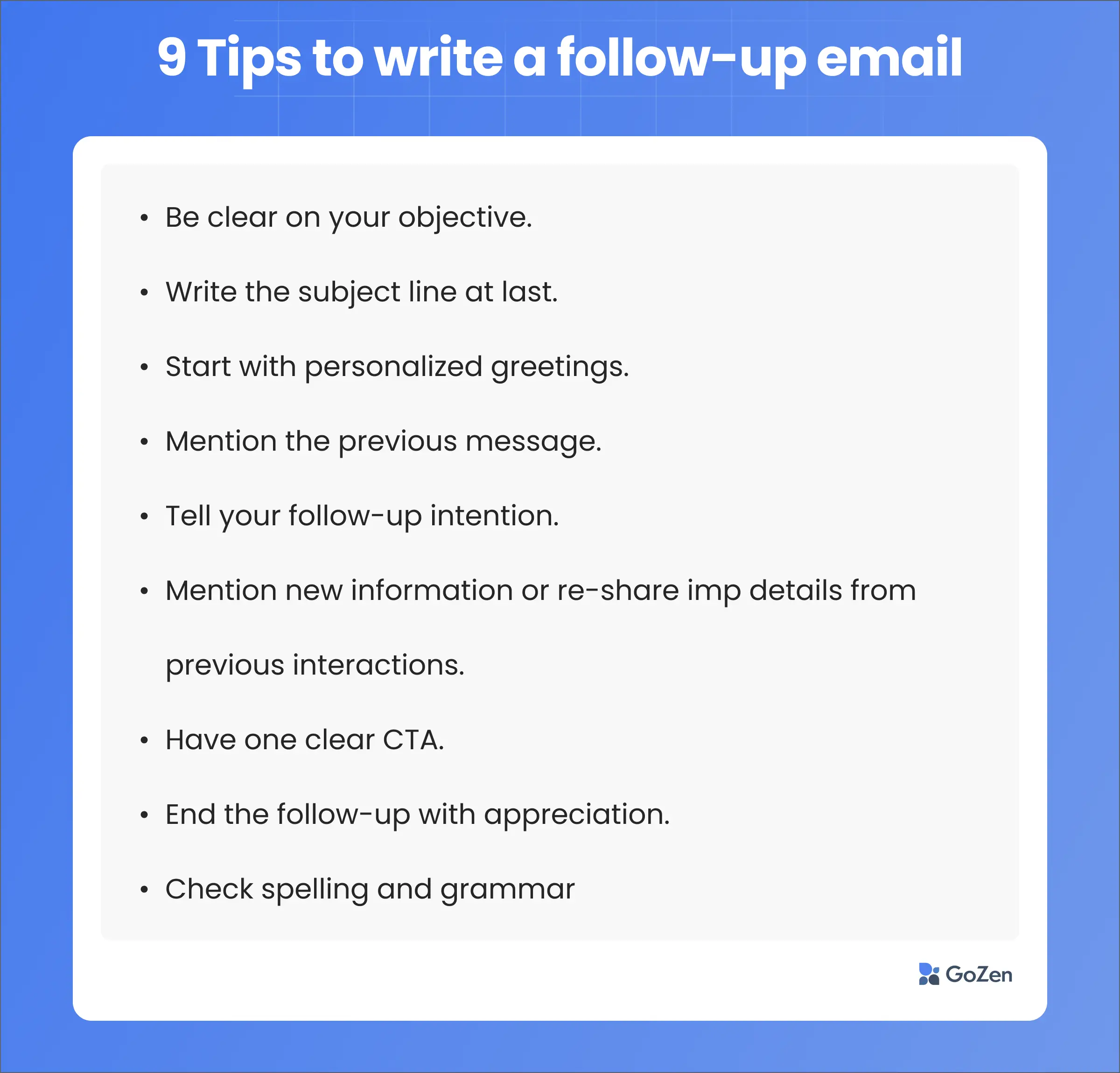
Be clear on your objective.
Before drafting your follow-up email, take a moment to understand its purpose.
Are you looking for a response, an update, or prompting an action?
It’s a common pitfall for many marketers and professionals to write follow-ups without a clear goal in mind.
This can lead to ineffective communication and missed responses. It’s like writing a follow-up just for the sake of it.
Write the subject line after writing the email body
Start by writing the body of your follow-up email.
Why? Because it’s simpler that way.
Once you’ve written the body, you’ll have a better understanding of what to highlight in the subject line to encourage your recipients to open your email.
Here are some additional tips for crafting your follow-up email subject line:
Keep it Short: Aim for brevity. Long subject lines can get cut off on mobile devices. (Typical, We all know this for centuries)
Add Personalization: At GoZen, our email campaigns have an average open rate of 40%, which is significantly higher than the industry average.
We achieved this by adding personal touches, like including the recipient’s name and company name.
This is what it looks like - {First name}, {Company name} Revenue?
Ask Open-Ended Questions: Pose questions related to the problem you discussed in the first email, or anything else that might pique your prospect’s curiosity.
E.g., Here’s the open ended + Curiosity mix subject line we used for our email campaign - John, Radar group’s Revenue?
Make sure the question you ask doesn’t allow for a simple ‘no’ answer.
Like this, ‘Want to increase your revenue?’and the prospects be like - Of course, No - I know this type of email very well.
Avoid Passive Aggression: Clean off desperate and passive-aggressive subject lines in your follow-ups.
For example, avoid phrases like “I know you’re busy; I’m busy too.”
Here are some examples of passive-aggressive follow-up subject lines to avoid:
1. I’ve tried to reach you a few times now
2. I know you’re busy; I’m busy too
3. Any updates on this? Friendly reminder
Don’t Show Desperation: Avoid showing desperation or distress in your subject line.
Phrases like “If it’s not too much trouble” or “I apologize in advance for bothering you” can come off as desperate.
Start with a Personalized Greeting.
Even in a follow-up email, it’s essential not to overlook the courtesy of addressing the prospect by their name.
When sending out a mass email, consider including a prospect’s first name in the email, right after the greetings ‘Hi’or ‘Hola’or whatever that’s relevant to your business and country.
As Dale Carnegie noted in his book ‘How to Win Friends and Influence People,’ “A person’s name is to that person, the sweetest and most important sound in any language.”
If you’re sending follow-ups to only a few people, Try including something that’s personalized to them.
If you have their LinkedIn profile, get into it and find something you can praise them for. It could be about their job, achievements, books, or anything.
Because flattery always influences people and makes them pay attention to your email.
Mention about previous email’s message.
When reaching out, it’s always a good idea to reference your previous communication or interaction.
Like this,
Hi [Recipient’s Name],
I hope you’re well. Just a quick follow-up regarding our recent discussion on [specific topic]. If you need any further details or have questions, feel free to reach out.
Thanks,
[Your Full Name]
This helps jog the recipient’s memory about who you are and why you’re getting in touch.
Even if your prospect has opened and read your email, they might not remember all the details.
So, it’s wise to include a sentence at the beginning referring to your previous message or information.
Doing this can achieve two things:
1. It can serve as a reminder about the previous email they’ve read.
2. It can spark their curiosity to revisit the previous email to understand the context of your message.
Either way, this approach helps people grasp the situation better and make an informed decision.
Retell Your intention about following up.
Once you’ve established the context of the email, it’s time to get straight to the point - why are you following up?
The best approach here is to be direct and concise.
It might feel a bit abrupt, and you might worry about coming off as impolite. But remember, it’s important to respect your prospect’s time.
Here’s what it could look like:
I’m following up on the Construction Invoice Receipt Templates I sent last week. Have you had a chance to review it?
“Just checking in to see if you’ve had time to consider our offer.”
“I wanted to touch base regarding the contract we discussed. Any updates?”
“Following up on the product demo we had last week. Do you need any more information?”
“I’m circling back to see if you’ve made a decision about the project proposal.”
Mention New Information or Re-share Important Details from previous interaction.
Share any new details that might be of interest to the recipient or remind them of important information from your previous interaction.
This is how it looks like,
“Hi [Recipient’s Name],
I hope this email finds you well. I’m reaching out to follow up on our previous conversation regarding the [specific topic or proposal].
Since our last discussion, there have been some exciting developments that I believe could be of interest to you.
[Provide new information here. This could be an update on the project, a new feature, a recent achievement, etc.]
Additionally, I wanted to reiterate the key points from our initial conversation that I believe are particularly relevant:
[Re-share important details here. This could be the benefits of your proposal, the potential impact on their business, etc.]
I believe these updates further underscore the value that our [product/service/collaboration] can bring to your [business/team/organisation]. I’m looking forward to hearing your thoughts and discussing the next steps.
Best Regards,
[Your Name]”
Including this gives a valuable reason for your prospect to reply.
Give one clear CTA.
It’s better to keep the call to action (CTA) simple and direct — the next step your prospect should take after reading your email.
Avoid asking them to perform more than one action.
From my experience with cold email campaigns, I’ve noticed that we see a higher click rate when we include multiple CTAs. (You know, the more links to click, the higher the click rate)
However, because the action isn’t focused, the desired outcome, such as booking a demo, often decreases to nil.
Interestingly, when we eliminated all other CTAs and concentrated the entire email on a single CTA, the click rate was lower than before.
But the results? They were impressive. We saw double the number of demo bookings.
So, the takeaway is clear: a focused, single-action CTA can lead to more effective outcomes, even if it means a lower overall click rate.
End the follow up with a bit of appreciation
Consider this: your potential client dedicates their valuable time to reading your follow-up emails.
Even if they don’t respond, it’s a nice gesture to show some appreciation for their time.
Here are a few ways you could express your gratitude
1. Thank you for your time. I’m looking forward to connecting with you soon.
2. I appreciate you taking the time to read this. Enjoy your weekend.
3. Have a great weekend ahead. I’m eager to hear your thoughts on this.
Unknown to many, these small tokens of appreciation can add a personal touch to your follow-up emails, making them feel lighter and more human.
Check the spelling and grammar
Before hitting the ‘send’or ‘publish’ button on your follow-up email, check for grammatical and spelling errors. Your follow-up might sound slightly off, even after correcting these mistakes.
That’s why it’s a good idea to read your email aloud or ask a colleague to go through it. If you’re handling multiple professional or academic emails, using a writing service like EssayService can help refine your content, ensuring clarity, professionalism, and a polished tone that leaves a strong impression.
This can help you spot any hidden errors or awkwardly phrased sentences before your email reaches the intended recipient.
When to send a follow-up email?
Send your follow-up email after 2-4 days, avoiding Mondays and Fridays. Optimal times are 10 am, 2 pm, or 8 pm, considering the recipient’s time zone. Remember, testing different times is essential to find what works best for your audience.
Regarding timing, there are two key factors: the gap between emails and the specific time to send your follow-up.
Let’s discuss the gap between emails first. As a general rule of thumb, it is best to send your follow-up email after a gap of 2-4 days.
And remember, for reasons you’re likely aware of, it’s good to avoid sending follow-ups on Mondays and Fridays.
Now, let’s discuss the best time to send a follow-up email.
According to SEOpressor, 10 am is optimal because people’s minds are fresh and uncluttered.
Other effective times to send emails according to SEOpressor,
1. 2 pm: This is the middle of the workday when people might be looking for a distraction, like checking their emails.
2. 8 pm: Many professionals reserve their mornings for productive work and avoid marketing emails. So, the evening becomes an excellent time to check non-work-related emails.
Oh, and one more thing, don’t forget to consider the time zones your recipients are in.
But remember, like anything in marketing, everything should be tested.
What works for one company may not work for another due to time, situation, and luck.
So, don’t hesitate to experiment and find what works best for you.
How often should you follow up?
Send 3-5 follow-up emails, increasing the gap if sending 5-6. Only send follow-ups on business days. If there’s no response after the sixth follow-up, switch to monthly emails. Test and adjust based on results.
It’s generally recommended to send between 3-5 follow-up emails, considering a person typically says ‘no’four times before responding positively.
If you plan to send multiple follow-ups, like 5-6, it’s a good idea to increase the gap between emails.
Oh, and ensure you are sending the follow up emails only at the business days.
Here’s a visual representation of how it might look:

If your prospect hasn’t responded after your sixth follow-up message, it might be time to switch to sending one follow-up email per month.
But again, the above best practices must be thought critically and tested to find the truth.
How can I ensure my follow-up email doesn’t appear pushy or annoying?
Here are some tips to keep in mind when sending follow-up emails,
1. Avoid being salesy: We have already discussed ‘How to avoid being salesy in your initial sales pitches.’ This also applies to follow-up emails.
2. Add Value: Always ensure your email provides value to the recipient. This could be adding useful information, insights, or assistance.
3. Honest Subject Line: Make sure your subject line accurately reflects the content of your email. This helps set the right expectations for your prospect.
4. Don’t Rush: Avoid sending follow-up emails too quickly. Wait at least a day before you follow up. If you appear in their inbox too soon, you might seem desperate or intrusive.
5. Remind Them: Start your email by reminding the prospect of your last interaction. This helps to solidify the context in their mind.
6. Get Permission: Always ask permission to follow up and include an unsubscribe or opt-out link in every email. This respects the recipient’s right to control their inbox.
7. Avoid “Follow Up” in the Subject Line: Do not use “follow up” in your subject line. It doesn’t add value and might make the prospect feel blamed for not responding.
8. Don’t Push: Never force your prospect into anything.
When people feel pushed, they tend to bounce back, like ‘Whoa, Stop right there.’
Instead, give them options and ask soft questions like, “Would you be interested in attending a product demo? Feel free to ignore this if you’re not interested.” This ensures that the control remains in the prospect’s hands.
This is where soft selling comes into play. “Soft selling is a sales approach focused on building relationships and trust with potential customers rather than directly pushing for a sale.”
Refer to the below infographic to get a quick grasp on soft-selling:
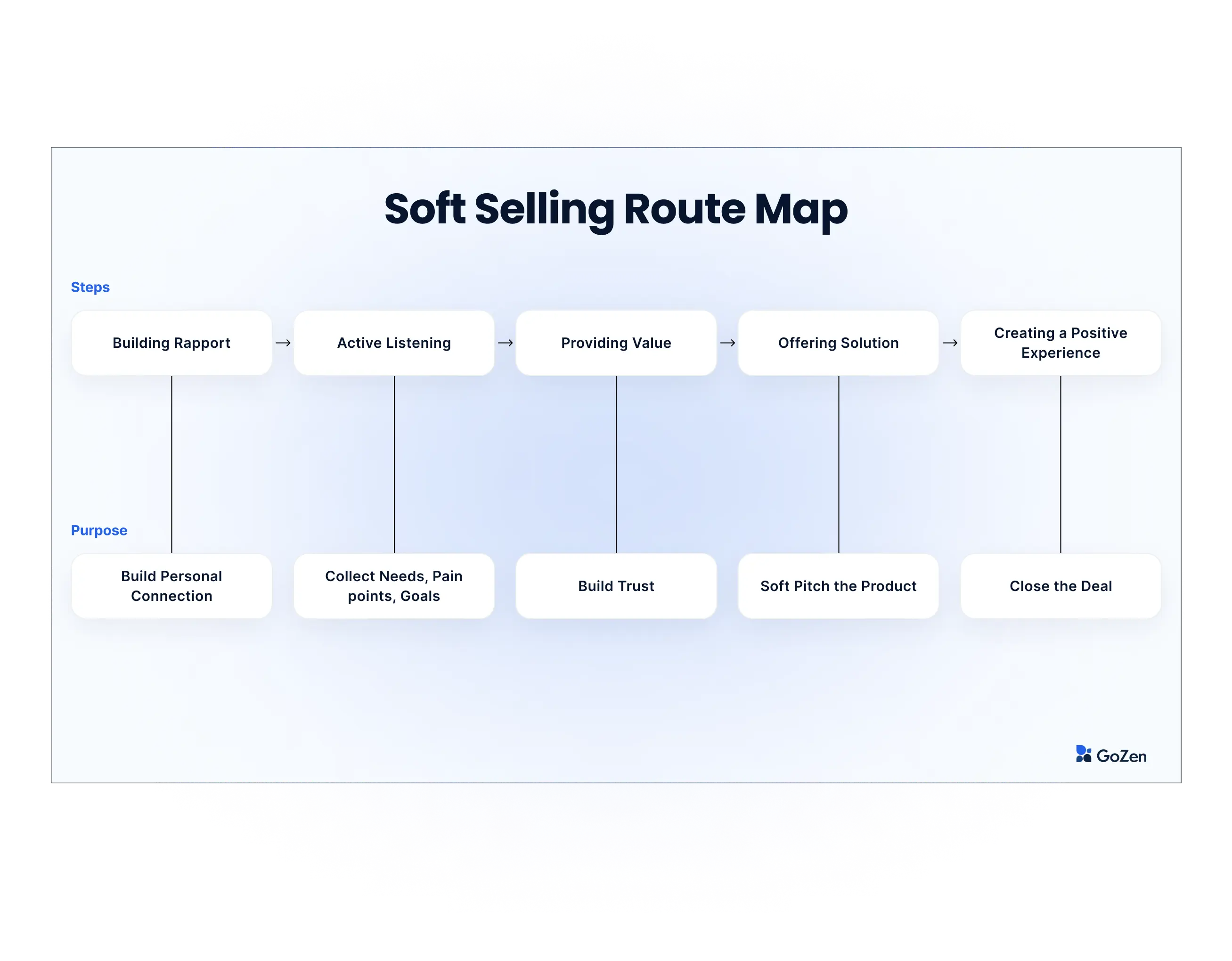
Read more about soft-selling here: How to sell without being salesy?
What tone should you use in your follow-up email?
Use a direct, concise, and professional tone. Show respect and empathy for the recipient’s time and needs, and stay polite by asking soft questions.
Like this:
Would you be interested in attending a product demo? Feel free to ignore this if it’s not relevant to you. Thank you for your time.
Here are some refined tips for crafting effective follow-up emails,
1. Be Direct and Concise: Aim to be clear and to the point in your communication. Avoid unnecessary details.
2. Maintain a Professional Tone: Keep your language formal and respectful. This helps in establishing credibility.
3. Show Respect and Empathy: Understand the recipient’s perspective and show consideration for their time and needs.
4. Stay Polite: Politeness can be challenging when seeking a response, but it’s crucial. One way to maintain politeness is by asking soft questions.
For instance, when inviting the prospect to a product demo, you could ask, “Would you be interested in attending a product demo? Feel free to ignore this if it’s not relevant to you. Thank you for your time.”
How do you automate your follow-up emails?
Automating your cold email follow up is so easy with GoZen Growth.
Follow the below steps to automate your follow up emails.
Step 1: Sign up for GoZen Growth (free)
Step 2: From the dashboard navigate to ‘Audience’
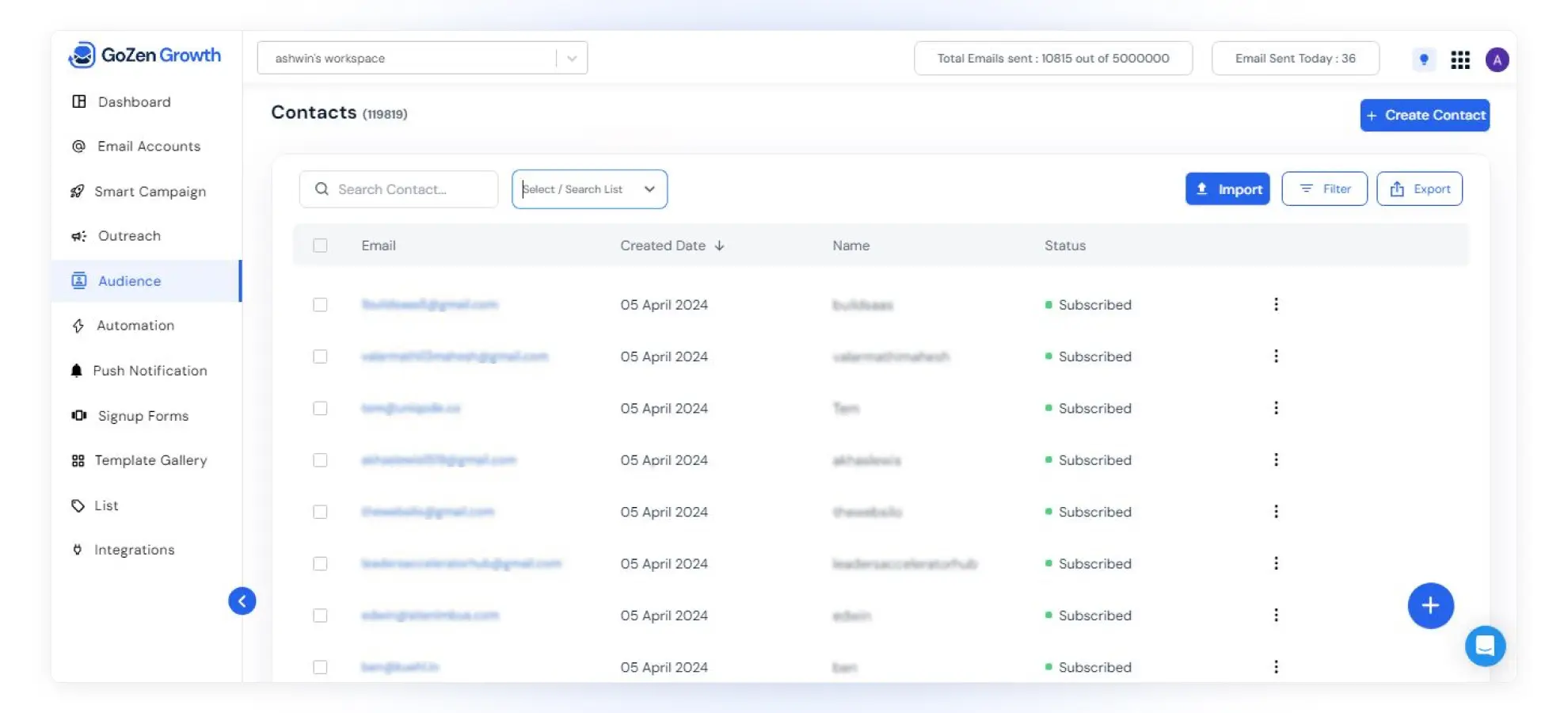
Step 3: Next, you’ll want to import your list. Do this by clicking ‘Import’and adding your list as a CSV file.
If you’re using Mail chimp or Optinly, you can connect both accounts and import directly.
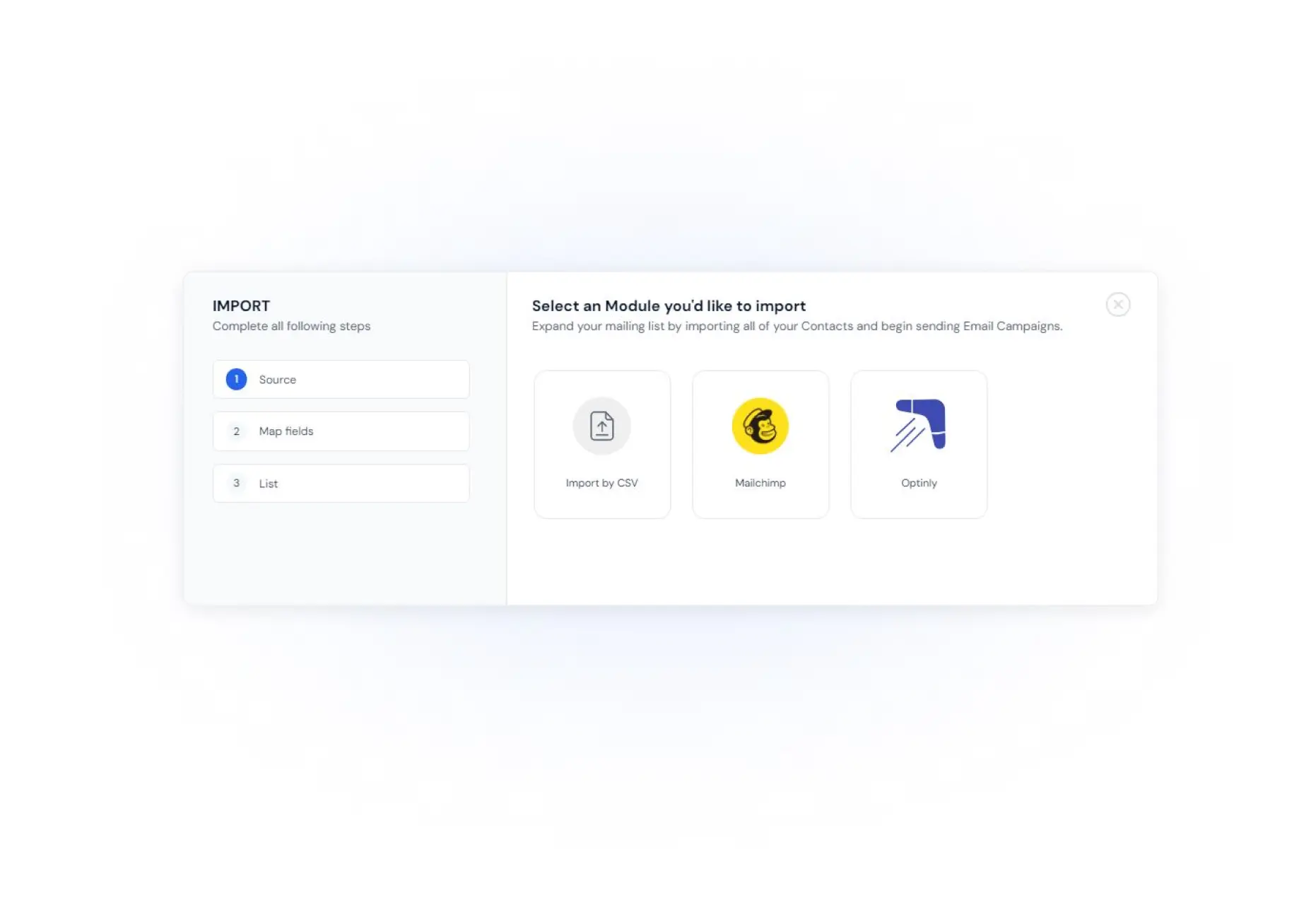
After you’ve imported your list, you’ll need to map the relevant fields from your Google sheet, like First Name, Last Name, and Company. After mapping,
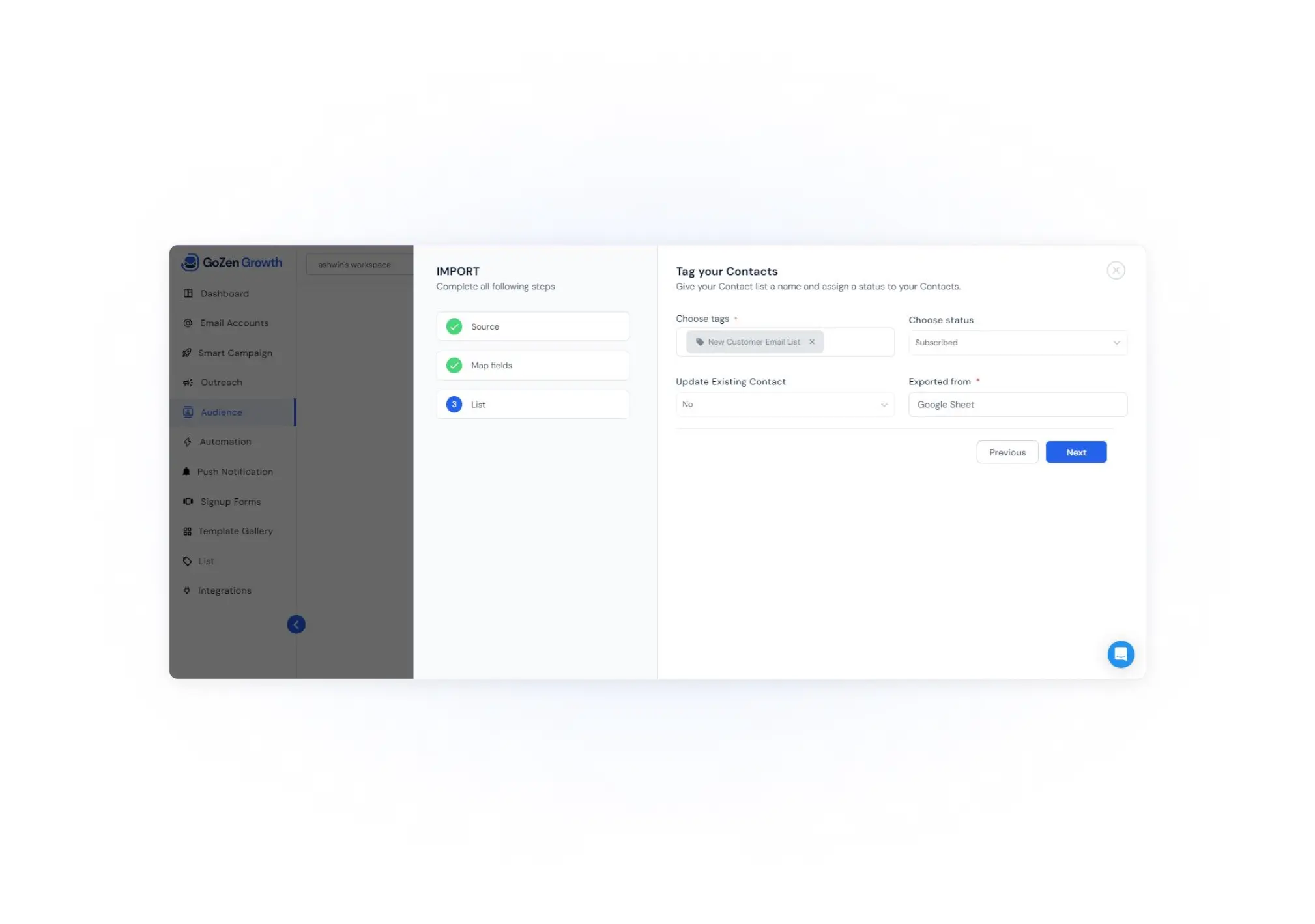
Click next, name your list under ‘Choose tags,’ select the status as ‘Subscribed,’ and choose yes or no under ‘Update existing contact.’ If you’re updating an existing contact, click yes, or if it’s new, click no.
Ensure that you name the source from which you imported the contact.
Then click next - That’s it. You’ve uploaded the contact inside GoZen Growth.
Now, let’s move on to automating your follow-up email.
Follow the steps below.
Step 1- From the dashboard, click ‘Smart Campaign.’
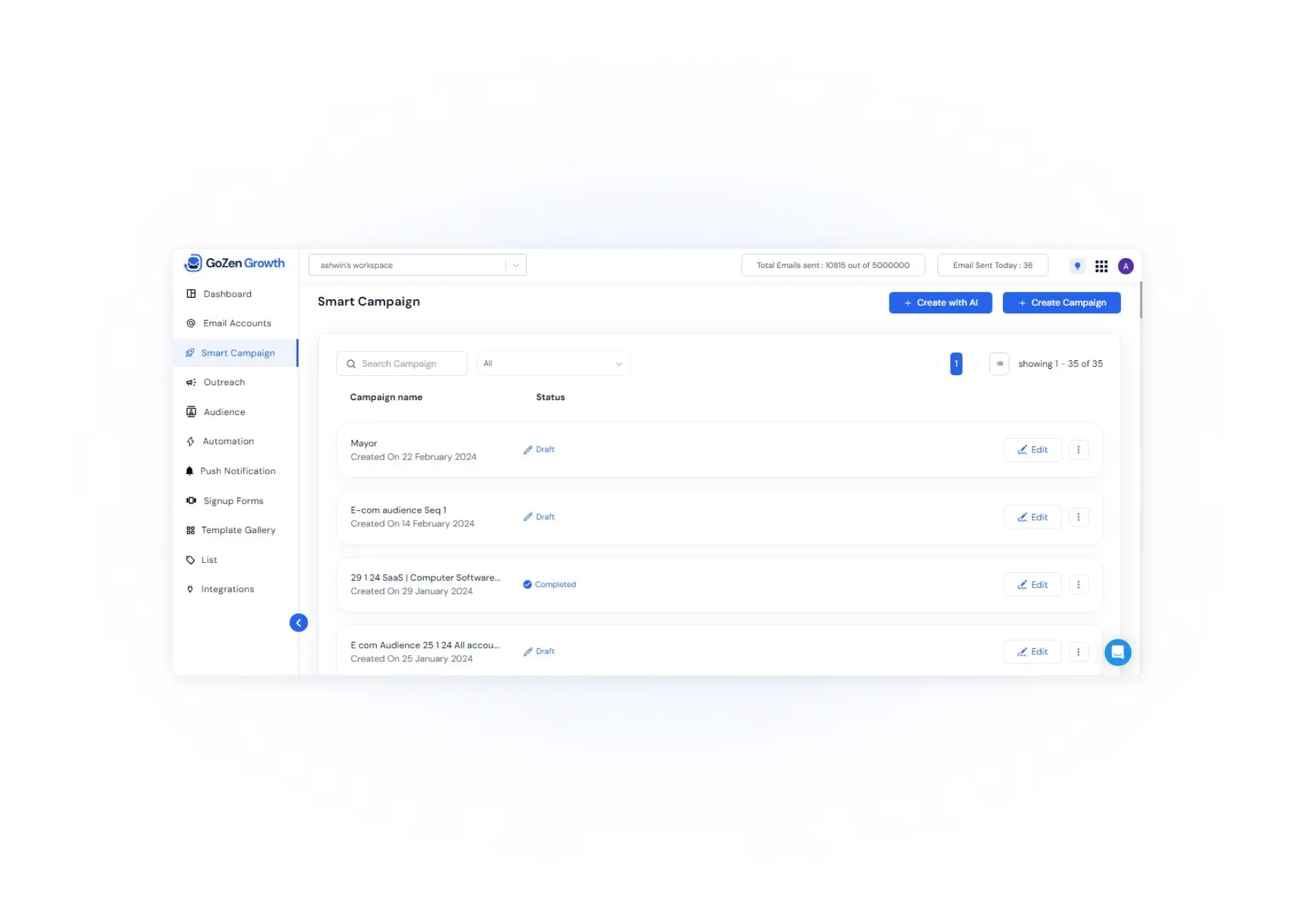
You can either use ‘Create with AI’ or ‘Create Campaign’ to write your cold email sequence.
Assuming you already have the email copy,
Step 2: Click ‘Create Campaign,’ give your campaign a name, and hit ‘Create.’
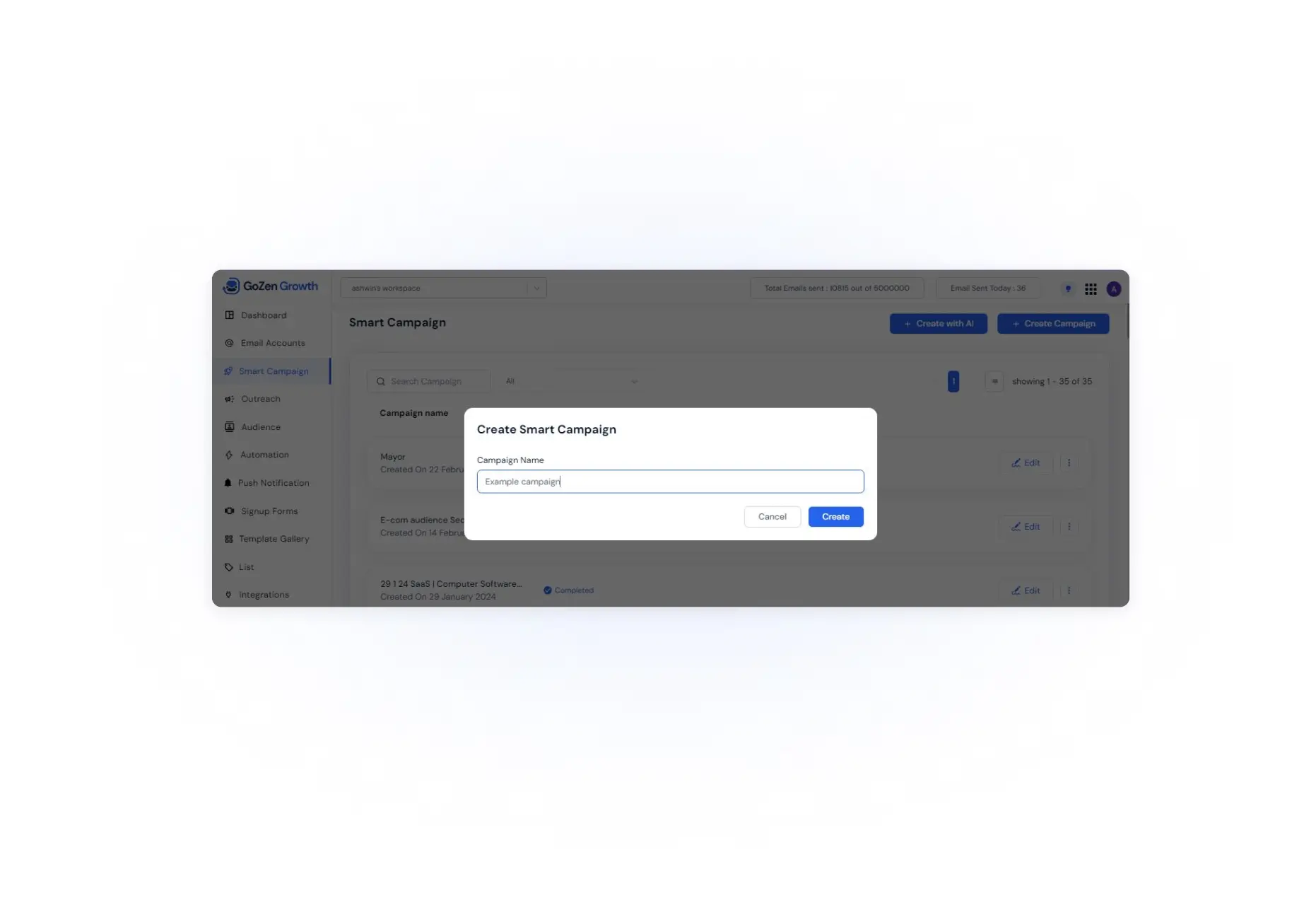
Then, you’ll move to the part of the sequence where you can paste your cold email copy.

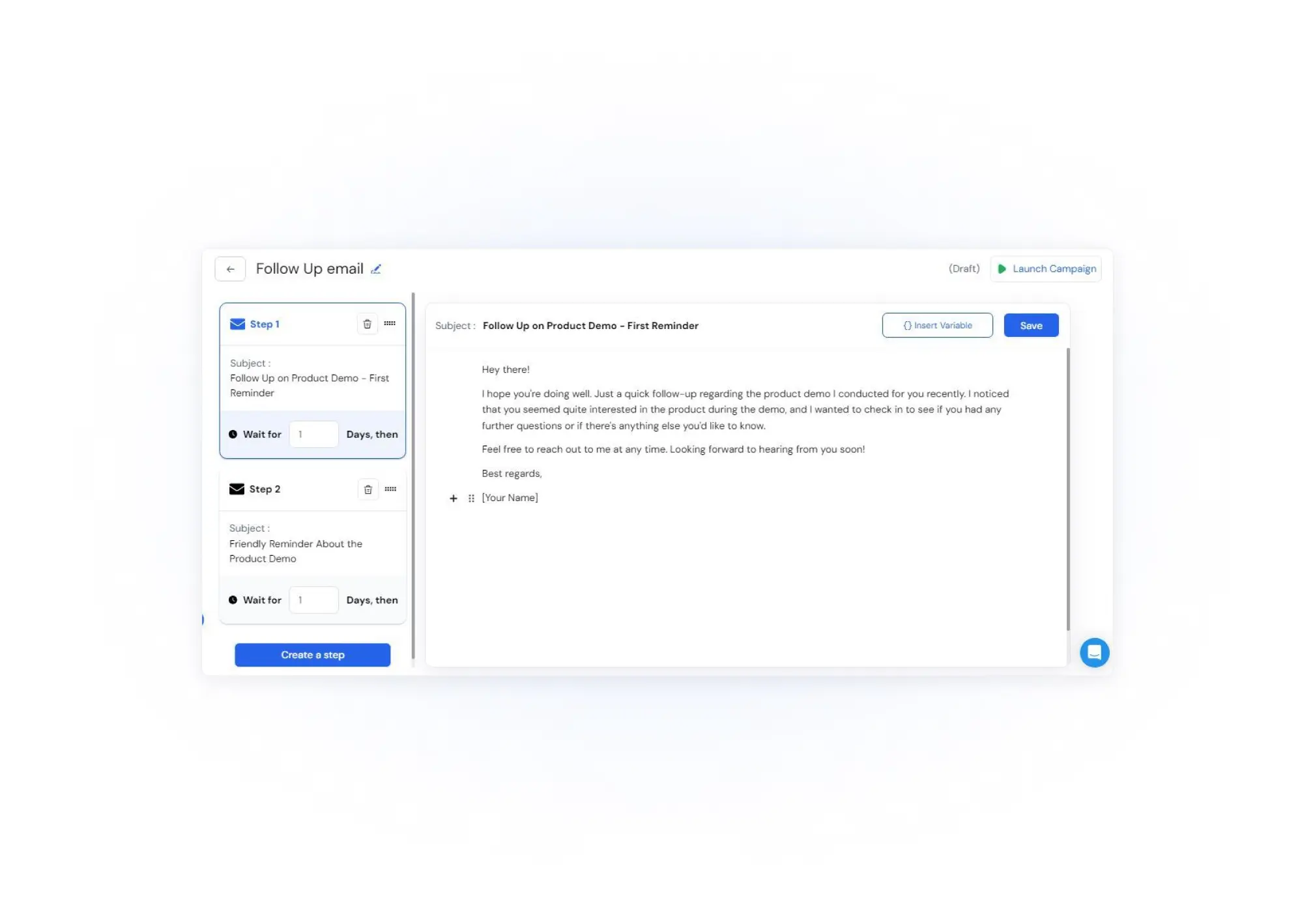
Step 3: To add another sequence, click ‘Create Next Step’.
You can add as many sequences as you want to your campaign.
To automate the follow-up, paste your follow-up email copy in the following sequence - the 2nd sequence you can see above.
Step 4: Choose a time gap between the first and follow-up emails. ‘Wait for (Days gap between the first and follow-up email) then,’
After pasting the follow-up email copy and choosing the days gap - Click ‘Save’ in the top right corner.
After saving, Navigate to ‘Schedule.’

Choose the email from which you’ll be sending the campaign - You can choose 1 or multiple email accounts.
(Which will be rotated equally - Saving you time and effort to manually create a campaign for each account)
Then, set up your desired schedule.

Under the tracking, Select the things you want to track.

You can even choose the sending pattern, for example, ‘Max number of emails per day.’
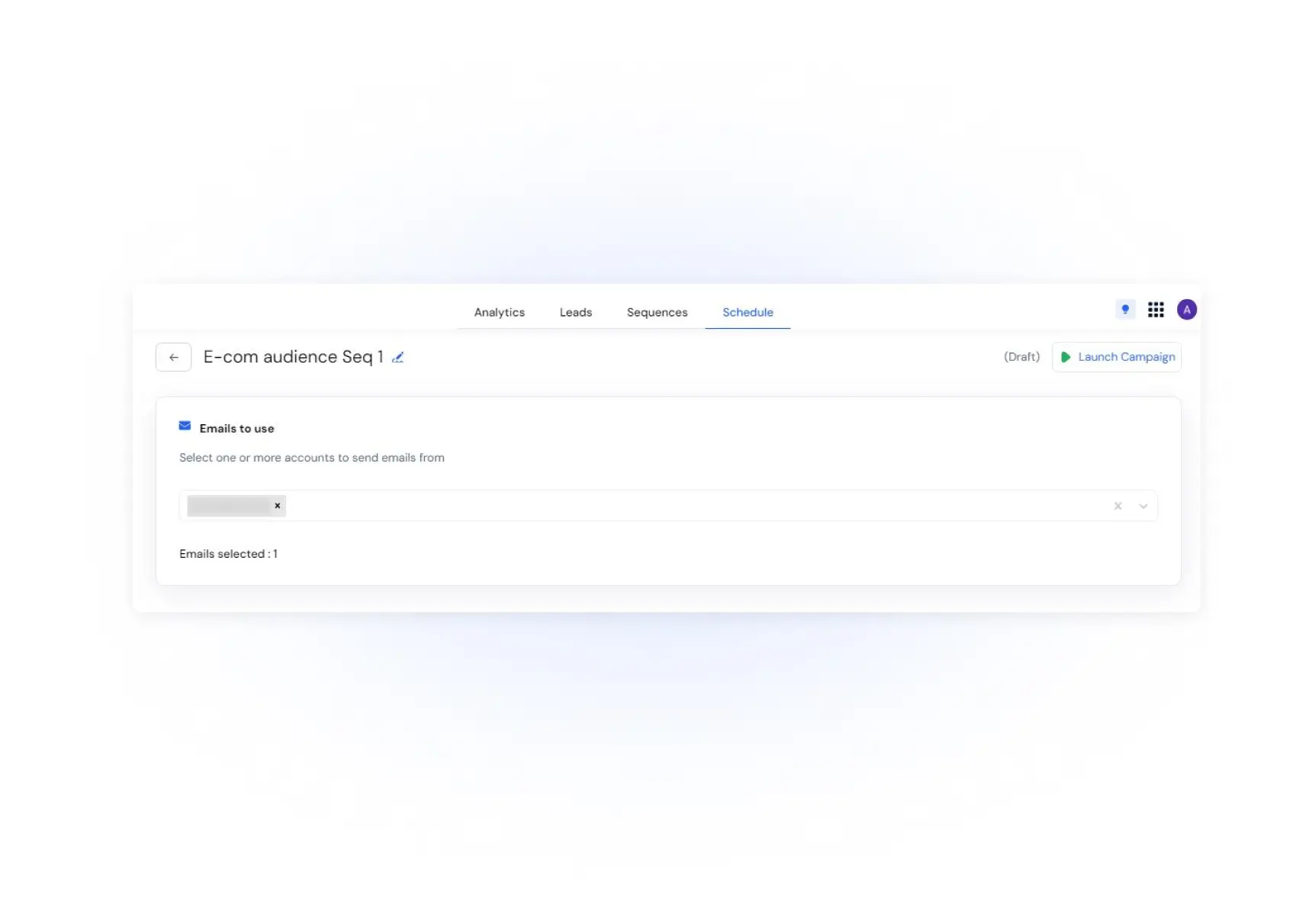
After choosing all the scheduling things, Click ‘Launch campaign’ and you’re ready to go.
What are the best practices for sending follow-up emails?
1. Don’t send follow-ups quickly. Wait for at least a day or two.
2. Keep the copy simple. Use the Hemingway editor to remove unwanted words from your follow-ups.
3. Avoid typos. You can use Content AI’s playground for this one.
4. Always end with one specific action your prospect needs to take.
5. Tell a short intro about yourself — Most of the time, your prospect forgets you and your emails; retelling about yourself, again, helps them recall or at least look at your previous email.
6. Add value —As I said in the sixth tip on writing a follow-up email, Provide new information or restate the previous one and give them a reason to reply to your follow-up message.
7. Write the subject line after the copy. When you write the subject line as the first thing, you won’t have any idea how to write one. But try writing it after the email copy.
You’ll get what words can trigger the prospect to open the email.
8. Be persistent But always non-salesy —There’s nothing wrong with sending 8-10 follow-up emails. The problem happens if you have an aggressive, intense, and pushing tone in them.
9. Include opt-out link —We’ve faced many issues forgetting to include the opt-out link in our emails; sometimes, not doing this will hurt your brand’s perception among your target customers.
There are instances where our annoyed prospects take this ‘Not including the opt-out link’ issue to social media.
10. Don’t say everything in one email — Have a list of things you have to say to your prospect and include each in multiple follow-ups.
Additionally, offer them something valuable in each follow-up email, but don’t directly ask them to buy something. Consider it as a narrative gradually moving towards the final reveal. It goes like this,
Follow Up 1- “Our solution helped companies like yours grow revenue without ads. Do you want to know how?”
Follow Up 2 - Our solution reduced Google Ads spending by 60% for a similar company. Are you intrigued?
Follow Up 3 - “Let’s dive into the blueprint on how to automate your company’s revenue without ads, Wanna Join?”
What if you don’t hear back from your follow-up?
Wait at least 3 business days before sending another follow-up. Restart the conversation from your initial email, use humor to lighten up, and avoid sending breakup emails. Instead, pause for a few days or months, then reinitiate contact.
1. Wait at least 3 business days before sending another follow-up.
2. Restart the conversation from the initial email you’ve sent.
3. Use humor to lighten up the situation - Talking about a funny cold email, Here’s an example I find fascinating,

Img Source - marketingexamples
4. Never send a breakup email - It’s natural to send a final email after a series of no responses from your follow-up email - But the business is not done yet; instead of entirely stopping your email to that person, Wait for a few days or months, then start the conversation again like the below,
“I hope you had a great Christmas! I know a lot of customers are focused on generating revenue organically. Is this a priority for your company right now?”
How to Send a Follow-Up Email After No Response?
Here are some professional and ethical tips for sending a follow-up email after no response:
Wait a Reasonable Time
Give the recipient enough time to respond before sending a follow-up. A good rule of thumb is 3-5 business days.
Example: If you sent the initial email on a Monday, consider sending the follow-up on Thursday or Friday.
Use a Clear Subject Line
Ensure your subject line is concise but adds value and context to your follow-up, making it stand out in a busy inbox.
Don’t use the word ‘Follow-up.’ Because it’s too generic, everyone uses it, it provides no value, and sometimes the word sounds like you are hurrying the person on the other side.
Examples:
Polite Reminder of the Previous Email
Briefly mention your initial email to refresh the recipient’s memory, adding context or value to make it more compelling and memorable.
Don’t use the word ‘Follow-up’ here too.
Examples:
Retell Your Request or Offer
Restate what you are asking for or offering.
Example: “I was hoping to get your feedback on the proposal I sent” or “I wanted to discuss the partnership opportunity.”
Add Value
Provide additional information or insights to make the follow-up email more valuable.
Example: “I have attached a case study that might help illustrate my point.”
Keep It Short and Sweet
Follow-up emails should be concise and to the point.
Example: Limit the email to a few short paragraphs or bullet points.
Include a Call to Action
Make it clear what you want the recipient to do next.
Example: “Could we schedule a call this week to discuss further?” or “Please let me know if you need any more information.”
Express Gratitude
Always thank the recipient for their time and consideration.
Example: “Thank you for your attention to this matter. I look forward to hearing from you.”
Be Professional and Courteous
Maintain a professional tone and avoid sounding frustrated or demanding.
Example: “I understand you’re busy, but I would appreciate a moment of your time.”
Follow Up Multiple Times if Necessary
Sometimes, getting a response takes more than one follow-up, but don’t overdo it.
Example: Send a second follow-up after another week if you still haven’t received a response.
Top 10 Mistakes to avoid while sending follow-up emails.
1. Not including the unsubscribe button —Many trusted brands worldwide have paid penalties for not including the unsubscribe button.
2. Showing custom fields instead of personalization - To avoid this mistake, always test-send an email to yourself and your teammates before sending it.
For example,
Hi {{first.name}} (This is awkward)
Have you checked out this new AItech called Voice engine?
Can Isend you a doc on how your company can make use of it?
Thanks, Merriam
Deltin Company
3. Not setting up enough follow-up emails —It’s okay and even reasonable to think that “Sending too many follow-ups may frustrate the prospect, and it might ruin the brand.”
However, according to the data, your prospect says 4 NOs before saying yes to your offer or replying.
You should send at least 5 follow-up emails to ensure prospects convert.
4. Not personalizing your follow-up — You might think you should personalize only the initial emails but not the follow-up ones.
However, According to the Backlinko, cold emails with personalized body messages get 32.7% response rate.
5. Lack of proper research—Whether you send cold emails or follow-up emails to a few hundred or thousands of prospects, at least research their business or company.
This gives you enough clarity and confidence to write converting follow-ups and cold email copies.
Doing research for at least 3 hours can save you from sending vague and non-connecting cold emails and follow-ups.
6. Only send sales-oriented follow-ups —Forget your product and send them resources to solve their problem, such as articles, eBooks, videos, etc.
I get it, The pressure to close deals and generate revenue for the company; I completely get it,
However, these educational resources can teach your prospects more about their problem, which increases their desire to solve it, making them more receptive to your emails where you talk about youroffer.
7. Showing the signs of pushing —I get it; each follow-up without a response, the natural tendency is to get annoyed and send pushy follow-ups to force them to take action.
But we have to restrain that emotion and use a polite and helpful voice in each follow-up.
8. Not including social proof - Social proof is one of the most effective psychological factors that affect people’s decisions about everything.
Show proof that what you’re claiming to your prospect is real and has worked for many people like them.
Yeah, including social proof in follow-up emails can direct your prospect’s purchase decision toward your product.
This is the social proof content we use in our emails,
“6000+ businesses across the world automate their organic marketing and generate revenue without ads.
And this,
GoZen has 1,135+ 5 star reviews across popular review platforms.”
9. Messy Call to Action—You should ask your prospect to take only one action —no two or three—one follow-up, one action.
Don’t ask your prospects to do many things in one follow-up. It’ll confuse your audience and get them distracted.
10. Writing longer follow-up emails - The shorter the follow-up, the easier it is for prospects to read quick and reply - The longer it is…Well, you know, Will you read long emails? No, Will I read longer emails?
No one will read longer emails.
Whatever you’re coming to say in the following up,
First, write longer, pouring all the things you have to say, Then cut it into separate information - You might get 2-3 follow-ups worthy content,
Then take those 2-3 follow-up worthy content and trim it down, removing all words and sentence frameworks that are confusing and taking longer to get to the point,
There you have it—the slimmer follow-up email copy that your prospects can read, understand, and reply to.
How can you automate writing follow-up with GoZen Growth AI?
No matter what kind of follow-up you wanna write, You can write it with Growth - Just give a prompt, and It’ll take care of it,
Step 1: From the dashboard, navigate to ‘Smart Campaign’and click ‘Create with AI.’
Step 2: Click ‘Create with AI’and provide instructions on how you want your follow-up email to look.
Step 3: After giving the prompt, click ‘Create’; that’s it; your follow-up copy is ready.
FAQ
Should you follow up after a ‘No’ from a prospect?
You shouldn’t follow up after a ‘No’ from the prospect.
Once they explicitly indicate that they’re not interested, It’s best to respect their decision and not follow up.
Conclusion
Here are the quick, important points to write a high reply rate follow-up email copy,
Have a clear objective before writing your follow-up emails. Are you looking for a response or trying to update them on information?
Write a short, non-pushy subject line.
In the body of your email, start with a friendly greeting and a quick reference to your previous interaction. This will jog the recipient’s memory and establish context.
Then, state your purpose. Be concise and avoid rambling. Get to the point.
End your email with a call to action (CTA) and a token of appreciation. The CTA should be clear and direct.
Thanking the recipient for their time shows respect.
Question
What do you think is the hardest part in running the cold email campaign?


